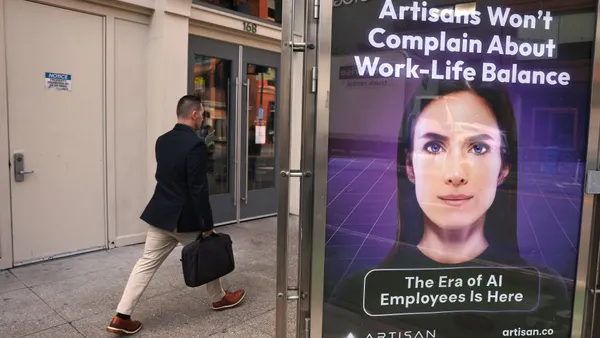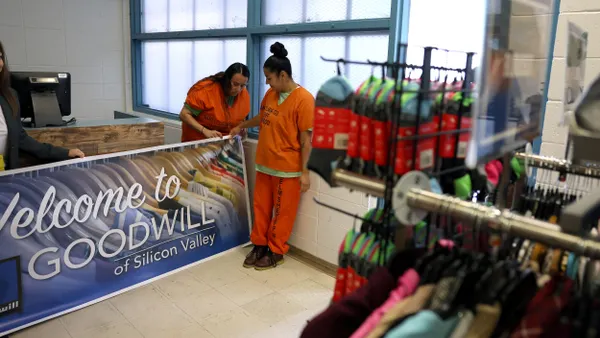NASHVILLE, Tenn. — When Candi Castleberry Singleton was asked to head up diversity initiatives at Sun Microsystems 18 years ago, her first reaction was: "That's a real job?"
Turns out, it's very much a real job — and Castleberry Singleton, now vice president of diversity, partnership strategy and engagement at Twitter, is a leading voice on the diversity conversation at Workhuman 2019.
That's not to say it's been easy. "Today in America, this is the hardest time to be doing diversity work," she told listeners during a panel. "This could be the loneliest job you ever do." Diversity execs, in particular, are usually considered the people who can change what everyone should have a part in changing — and are often held responsible for solving problems that the wider world hasn't figured out yet.
But answering the "how" has been key at #Workhuman. Castleberry Singleton joined a panel of diversity leaders and spoke with HR Dive directly to discuss exactly where talent leaders can start to make meaningful change.
Why diversity is hard
The importance of diversity, not just as the right thing to do but as a business imperative, was a key focus of conference panels and discussions at Workhuman 2019. As a business imperative, panelists noted, diversity and inclusion should be approached as such.
"I think we overthink that sometimes," Caroline Wanga, chief diversity and inclusion officer and vice president of human resources at Target, said during a panel focused on the topic of the workplace as a healing ground. The retailer's success in attracting shoppers depends on its ability to meet the needs and wants of those people, from all backgrounds and walks of life — and that is not a moral imperative, Wanga said. "It just is."
Some companies, however, are still early in their diversity journey and may not recognize the business and moral imperatives. "Everyday I'm selling diversity," Castleberry Singleton said in an interview with HR Dive. Inevitably, someone in the organization "still has to be convinced that they need it."
Whether a moral call to action or a dogged business argument will make diversity in-roads in a company depends heavily on the companies themselves, Castleberry Singleton said. But all companies must consider what they actually intend to gain from their diversity programs, including company training (a popular first step for many organizations).
Studies have shown that employees trust their workplaces to tackle these difficult subjects and promote healing, noted Carlos Cubia, global VP and chief diversity officer at Walgreens Boots Alliance. "Life doesn't just happen outside the workplace."
With diversity and inclusion — and especially with training — employees should be participating because they want to be participating. But usually, it is the "last thing anyone wants to do," Namrata Yadav, SVP and head of inclusion at Bank of America, said during the panel.
There has been a long evolution for diversity, inclusion and belonging efforts in the workplace.
"You started with a hammer," Howard Ross, founder and principal consultant at Cook Ross, said during the panel. "People would say what they needed to say to survive those sessions and then later they would say 'that was fine, but never make me do that again.'" Such an approach made people more afraid to talk about the subject, and did not help inclusion in the long-term, he said of earlier eras.
Make it actionable
"Human beings are not rational — they're rationalizing," Ross said. Very few of the decisions humans make are actually rational, he noted, so how is a D&I leader supposed to encourage difficult conversations when human nature fights them at every turn?
Yadav's team turned to education, but took out classroom components and engaged one on one with its employees to truly encourage people to shift to the new ways of thinking. The whole company had to make a push toward understanding and vulnerability. "If [employees] don't feel like someone is going to be there institutionally to help them, then what is the point?" she said.
Business resource groups are a good tool for this and were oft-cited throughout the conference. Diversity and inclusion leaders especially have to build networks with people who are not like them, and that includes people with whom they may not agree on all issues, Castleberry Singleton said.
Twitter shared its diversity numbers publicly and with its employees, which "is a pretty scary thing for D&I execs," she noted. But doing so creates accountability at the staff level — and most company leaders should not require data to understand a lack of diversity on their teams if diversity is obviously not there.
Whichever strategy is followed, one strategy will likely remain the same: "You have to find ways to disrupt that organic human behavior that everyone has," Castleberry Singleton said. And sometimes that behavior is absolutely conscious, she added. Good D&I leaders will understand that, and work with people to help them understand, too.
It's 'bigger than any one person'
Twitter's team realized that really solving diversity problems would require partnerships outside the organization — and that "one person can't do it all," Castleberry Singleton said.
Her title is new (as of last week, she said during a session), and her colleague Dalana Brand was recently named vice president of people experience and head of inclusion and diversity. The two women work together to bolster Twitter's intention to manage both internal and external diversity priorities.
"Most organizations start with HR," Castleberry Singleton said, including hiring, development and retention activities. If a company doesn't, it will have a hard time establishing credibility. But the external angle is just as important, Castleberry Singleton noted. In her position, she seeks to create a broader conversation in the tech industry about what diversity looks like and means.
"To have a sustainable impact, the tech industry will have to collaborate," she said. "Our world needs healing that no single person, company or country can solve for."
The impact of success
One of diversity's biggest struggles is that the work is constant, prompting "diversity fatigue" which stalls initiatives. But even for companies that are further on the diversity journey, the end goal — a world in which people of varying backgrounds are living and working together and yet are not at all the same — can feel daunting. The challenges of that world have yet to be fully understood, panelists noted.
"We live in a world that is working so hard to reach diversity and inclusion, but one that isn't teaching people how to live when we reach those expectations," Wanga said. A truly diverse world won't be one in which everyone is the same, and conflict naturally arises on the fault lines of difference. "We have to teach people to listen to each other courageously."
Disagreement doesn't have to be disrespectful, Castleberry Singleton said, and "if we don't figure this out, the world will never change."
"As long as I hear you," she said, "I'm learning."
Correction: A previous version of this article misstated the company where Castleberry Singleton was promoted into her first diversity and inclusion position. Her first D&I job was at Sun Microsystems.












